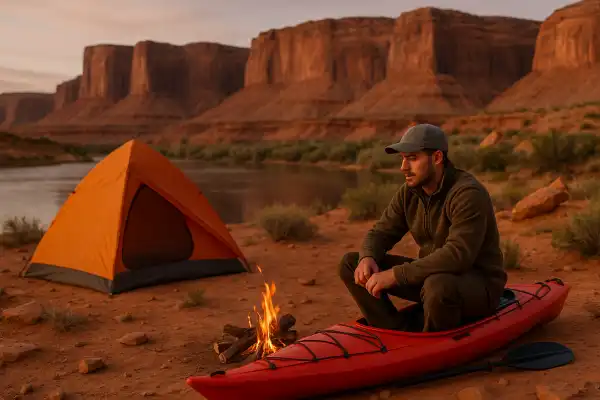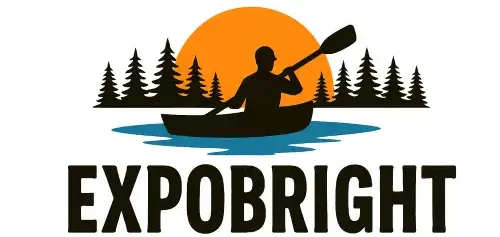Where can you kayak camp in Utah? Every paddler I meet seems to ask this question, especially when they discover the incredible diversity of water adventures the Beehive State offers. Last summer, I guided a family from Michigan who had no idea Utah held such spectacular paddling opportunities beyond its famous red rock landscapes.
The truth is, Utah’s network of pristine lakes, winding rivers, and vast reservoirs creates some of the most memorable kayak camping experiences in the American West. Whether you’re seeking alpine serenity or desert canyon solitude, Utah delivers paddling adventures that rival any destination.
Where can you kayak camp in Utah?
Utah offers exceptional kayak camping opportunities across its diverse waterways, from high-elevation mountain lakes to expansive desert reservoirs. You can camp along Lake Powell’s shoreline without permits in most areas, paddle to remote sites on the Green River system, or enjoy developed campgrounds at numerous state parks that cater specifically to paddlers.
The state’s kayak camping destinations fall into three main categories: developed state park campgrounds with water access, dispersed camping along designated river corridors, and primitive camping on large reservoir shorelines. Each offers distinct advantages depending on your experience level and desired amenities.

Alpine lake kayak camping destinations
Mirror Lake, nestled high in the Uinta Mountains, provides spectacular mountain reflections and excellent camping facilities. The lake sits at over 8,800 feet elevation, offering pleasant summer weather and fishing for unique trout species including tiger, rainbow, and brook trout. Multiple campsites surround the lake, with many offering direct water views, plus an amphitheater featuring live music and activities.
Silver Lake Flat Reservoir and Tibble Fork Reservoir, both located in American Fork Canyon, offer stunning freshwater camping surprisingly close to civilization. Silver Lake Flat sits about 15 minutes past Tibble Fork and attracts fewer crowds, though it’s only accessible via dirt road. The crystal clear water invites kayaking and swimming, with abundant trout fishing opportunities.
Bear Lake, straddling the Utah-Idaho border, features brilliant turquoise waters due to calcium carbonates and offers multiple camping options. Often called the “Caribbean of the Rockies,” its size makes it perfect for beginners who want to stay close to shore or explore gradually toward deeper waters. Bear Lake State Park provides kayak rentals, beaches, and parking, making it easy to launch.
Desert reservoir and lake camping
Lake Powell ranks among Utah’s most famous kayaking destinations, with nearly 2,000 miles of shoreline between Utah and Arizona. Primitive camping is allowed on most of the shoreline outside marina areas without permits or fees, though you’ll need a portable toilet unless facilities are within 200 yards. Popular dispersed camping areas include Lone Rock Canyon and Ice Cream Canyon, though reaching them requires paddling four to eight miles from launch points.
Red Fleet Reservoir, contained within Red Fleet State Park in northeastern Utah, offers unique kayak camping with 200-million-year-old dinosaur tracks accessible by paddling across the reservoir. The 750-acre reservoir provides excellent fishing, boating, and kayaking with nearby campground facilities. Kayak rentals are available at the park entrance, along with day-use areas and boat launches.
Deer Creek Reservoir sits in scenic Heber Valley, just a short drive from Park City, offering mountain views with fewer crowds than other popular destinations. The reservoir features calm waters, multiple launching points, and various camping options nearby, plus access to Deer Creek Island off the eastern shore.
River corridor camping opportunities
The Green River system provides exceptional multi-day kayak camping through Labyrinth and Stillwater Canyons, offering flatwater paddling suitable for all skill levels with opportunities for birding, hiking, and viewing ancient ruins and rock art. Seventeen designated river camps exist along the 125-mile stretch from Green River, Utah to the confluence with the Colorado River. Green River State Park serves as a popular launching point with renovated campgrounds featuring water and electric hookups.
The Provo River offers scenic class II paddling from Deer Creek Reservoir to Vivian Park, popular for kayaking and camping combinations. Both the North Fork and South Fork provide excellent fishing for rainbow trout, brown trout, and mountain whitefish, making this one of Utah’s designated “Urban Fisheries.”
The Colorado River’s “Daily” section near Moab provides developed camping at locations like Hittle Bottom, Rocky Rapid, and Sandy Beach. Special regulations apply: overnight camping on river right is allowed only in designated sites between Dewey Bridge and Salt Wash, while river left requires using BLM developed campgrounds.
Dispersed camping regulations and permits
All paddlers launching watercraft in Utah must complete an annual mussel-aware boater course and pay aquatic invasive species fees: $20 for residents, $25 for non-residents. Kayaks don’t require registration unless equipped with motors, and no operator licenses are needed. Personal flotation devices must be worn on all Utah rivers, and children under 13 must wear PFDs at all times.
Dispersed camping is available on Bureau of Land Management and Utah State Lands throughout much of the state, with 14-day limits typical. Some popular areas like Klondike Bluffs require portable toilets and have specific regulations. National park backcountry requires overnight permits with specific food storage requirements.
Westwater Canyon on the Colorado River requires advance permits obtained through Recreation.gov, available two months ahead of entry dates. Canyonlands National Park overnight permits cost $36 and allow up to 14 consecutive nights, with specific regulations for packrafting and river corridor camping.
Essential planning considerations
Water availability varies dramatically across Utah’s camping areas. Most dispersed sites provide no water sources, requiring paddlers to carry sufficient supplies. Lake Powell camping requires portable toilets unless facilities exist within 200 yards. State park campgrounds typically provide water, restrooms, and shower facilities.
Weather patterns demand careful timing. High-elevation lakes like Mirror Lake are accessible primarily during summer months due to snow. Desert reservoirs like Deer Creek experience strong afternoon winds, making early morning departures advisable. Lake Powell camping works best spring through fall, with extremely hot summer conditions.
Fire restrictions frequently change throughout Utah. State parks typically provide designated fire rings and prohibit fires outside these areas. River camping often requires fire pans meeting specific specifications, with fires prohibited entirely during high-risk periods.
Conclusion
Last year, I returned from a three-day paddle through Labyrinth Canyon with a group of first-time Utah visitors. Watching their faces as we drifted past towering red walls and ancient petroglyphs reminded me why Utah’s kayak camping opportunities remain unmatched. Following proper planning guidelines and understanding permit requirements transforms uncertainty into confidence, turning your Utah paddling dreams into unforgettable adventures beneath star-filled desert skies.
